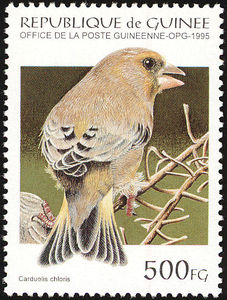We have been pondering on the significance of the laboratory evidence from Bee Researchers in France and the US that the administration of tiny amounts of a systemic neonicotinoid, imidacloprid, to bees was associated with a weakening of bee immunity, such that they became more susceptible to bee diseases. and decided to look more closely at the patterns of recent deaths/epidemics in the UK, Europe and the US, involving a variety of other wildlife. In the UK, greenfinch deaths (maximum number of deaths in the months August to October) from infections with Trichomonas gallinae, a protozoal organism which invades the bird‟s crop and mucosal lining of the beak, started around 2005 and has devastated the populations throughout Europe [1].
Apparently, the organism can survive only a matter of minutes outside its host, so if it were spread conventionally it would require direct contact between birds. In August 2009 there were reports of tens of thousands of songbirds, mostly greenfinches Carduelis chloris, dying in the west of Germany and the deaths spread across the border into the eastern Netherlands [2]. According to Hugh Jansman of Wageningen University, “The canker disease was first described as early as 1500, but was not found in wild songbirds until 2002”. It had been well known as a cause of disease in pigeons and doves, and birds of prey that fed on them, but had never been seen before in songbirds. By 2010, the population of greenfinches in central England had decreased by one third [3] and in March 2011, greenfinches, chaffinches and goldfinches are continuing to die from the disease [4].
References:
[1] Becki Lawson, Andrew Cunningham, Julian Chantrey, Laura Hughes, James Kirkwood, Tom Pennycott and Vic Simpson. (2006) Epidemic finch mortality. Veterinary Record 159: 367.
[2] Trichomoniasis in a greenfinch (Carduelis chloris) (2009).Dutch Wildlife Health Centre.
[3] Robinson, R.A., Lawson, B., Toms, M.P. et al. 2010 Emerging Infectious Diseases Leads to Rapid Population Decline of Common British Birds. PLoS one 5: e12215.
[4] www.bbc.co.uk.news./uk 29 March 2011 and www.rspb.org .
Authors:
Dr Rosemary Mason, MB, ChB (Hons), D.Obst. RCOG, FRCA.
She worked in the UK National Health Service for about 35 years in: General Hospital Medicine and Obstetrics 3 years; Training in Anaesthetics and Intensive Care 8 years; Consultant Anaesthetist (Anesthesiologist) 25 years. Author of Anaesthesia Databook; A perioperative and peripartum manual (600 pages) as a practical resource for trained anaesthetists. 1st edn. 1989, 2nd edn. 1994, 3rd edn. 2001; reprinted in 2009.
Assistant Editor of Anaesthesia, Journal of the Association of Anaesthetists of Great Britain and Ireland, 1990 – 2000.
Palle Uhd Jepsen, former Senior Adviser in Wildlife Management and Nature Conservation for the Danish Forest and Nature Agency, Ministry of the Environment. Research on the feeding ecology of goldeneye. Before his retirement he was a member of the Danish Delegation on the Ramsar Convention on Wetlands, International Whaling Commission, Bonn Convention on Migratory Species, ASCOBANS (Agreement on Conservation of Small Cetaceans in the Baltic and North Sea) and Wetlands International. Adviser on Site Management for International Projects in Thailand, Malaysia, Belarus, Northern Ireland and Estonia.
Author of several books on natural and cultural history in Denmark; also natural history in the Arctic.
27th May 2011

- Log in to post comments
